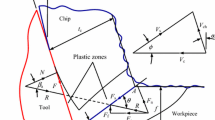Abstract
This paper describes the procedure for creating and verifying a thermomechanical FEM model of orthogonal cutting processes as well as the results obtained with this model. To verify the model, the temperature was measured in the secondary shear zone and at the exterior surface of the chip, which was analytically estimated as well and compared with the experimental values. In addition, the resultant forces and the chip compression ratio were determined as further characteristic machining variables. The course of the obtained results is explained using the correlation between the capacity produced by the heat source and its retention period in the temperature range under consideration. Finally, the values for temperature, resultant forces and chip compression ratio as attained by experiment are compared with those calculated with the FEM cutting model.











Similar content being viewed by others
References
Hoppe S (2003) Experimental and numerical analysis of chip formation in metal cutting. Dissertation, RWTH Aachen
Söhner J (2003) Beitrag zur Simulation zerspanungstechnologischer Vorgänge mit Hilfe der Finite-Element-Methode. Dissertation, Universität Karlsruhe
Xie L (2004) Estimation of Two-dimension Tool Wear Based on Finite Element Method. Dissertation, Universität Karlsruhe
Mackerle L (1999) Finite-element analysis and simulation of machining: a bibliography (1976–1996). J Mater Process Technol 86:17–44
Marusich TD (2005) Trends in machining modeling. Third Wave AdvantEdge International Users’ Conference, Dearborn, USA, 1–25, May 4–5
Özel T, Altan T (2000) Process simulation using finite element method—prediction of cutting forces, tool stresses and temperatures in high speed flat and milling. Int J Machine Tools Manuf 40:713–738
Pabst R (2008) Mathematische Modellierung der Wärmestromdichte zur Simulation des thermischen Bauteilverhaltens bei der Trockenbearbeitung. Dissertation, Universität Karlsruhe, 250 S
Fang G, Zeng P (2005) Three-dimensional thermo-elastic-plastic coupled FEM simulations for metal oblique cutting processes. J Mater Process Technol 168:42–48
Grzesik W (2006) Determination of temperature distribution in the cutting zone using hybrid analytical-FEM technique. Int J Mach Tools Manuf 46:651–658
Jen T-C, Anagonye AU (2001) An improved transient model of tool temperatures in metal cutting. Trans ASME 123:30–37
Warnecke G, Oh J-D (2002) A new thermo-viscoplastic material model for finite-element-analysis of the chip formation process. Annals of the CIRP 51(1):79–82
Majumdar P, Jayaramachandran R, Ganesan S (2005) Finite element analysis of temperature rise in metal cutting process. Appl Therm Eng 25:2152–2168
Potdar YK, Zehnder AT (2003) Measurements and simulations of temperature and deformation fields in transient metal cutting. J Manuf Sci Eng 125:645–655
Jen T-C, Anagonye AU (2001) An improved transient model of tool temperatures in metal cutting. J Manuf Sci Eng 123:30–37
Cereti E, Filice L, Umbrello D, Mican F (2007) ALE simalation of orthogonal cutting: a new approach to model heat transfer phenoma at the tool-chip interface. Annals CIRP 56(1):69–72
Zaghbani I, Bouzid W, Sai K (2005) A thermo-mechanical coupled F.E.M model for orthogonal cutting. 8-th CIRP International Workshop on Modeling of Machining Operations, May 10–11, Chemnitz, Germany
Davies MA, Ueda T, M’Saoubi R, Mullany B, Cooke AL (2007) On the measurement of temperature in material removal processes. Annals CIRP 56(2):581–604
Müller B (2004) Thermische Analyse des Zerspanens metallischer Werkstoffe bei hohen Schnittgeschwindigkeiten. Dissertation, RWTH Aachen
Kalhöfer E, Kranzen J (2010) Untersuchung der Zerspantemperaturen beim Bohren mittels Thermografie. horizonte, Nr. 35:32–34
Mayr J, Jedrzejewski J, Donmez MA (2008) A other: Thermal Error Research. CIRP Annals Manuf Technol 1–26
Nau M (2004) Elektrische temperaturmessung mit thermoelementen und Widerstandsthermometern. JUMO GmbH, Fulda
Heisel U, Krivoruchko DV, Zaloha VA, Storchak M (2007) Cause analysis of errors in fe prediction orthogonal cutting performances. Proceedings of the 10th CIRP International Workshop on Modeling of Machining Operations, -Calabria, pp 141–148
Heisel U, Kryvoruchko DV, Zaloha VA, Storchak M, Stehle T (2009) Thermomechanische Wechselwirkungen beim Zerspanen. ZWF Nr. 4:S263–S272
Kragelskiy IV (1978) Friction, wear and lubrication. Mashinistroenie, Moscow, 1:400
Fundamental of Cutting: Textbook/N. P. Mazur et al (2010). New World, Lemberg, p 422
Reznikov AN (1981) Thermal physics of cutting. Moscow, Machinebuilding. p 279
Oxley PLB (1989) Mechanics of Machining, an Analytical Approach to Assessing Machinability. Ellis Horwood, Chichester p 242
Krivoruchko DV (2010) Fundamental of cutting modeling with numerical methods. Thesis Dr. Sc. tech., Kharkiv, p 40
Bobrov BF (1975) Fundamental of metal cutting theory. Machinebuildung, Moscow, p 344
Heisel U, Storchak M, Eberhard P, Gaugele T (2011) Experimental studies for verification of thermal effects in cutting. Annals WGP Prod Eng 5(5):507–515
Jaspers SPFC (1999) Metal cutting mechanics and material behaviour. Technische Universiteit Eindhoven, Eindhoven 173 p
Heisel U, Storchak M, Stehle T, Korotkih M (2010) Temperaturbestimmung in den Zerspanzonen. wt Werkstattstechnik online, Bd. 100, No. 5:365–370
Acknowledgments
The presented results were gained in the project HE 1656/146-1 “Modelling and Compensation of Thermic Processing Influence for Short Hole Drilling” within the priority programme SPP 1480 “Modelling, Simulation and Compensation of Thermal Effects for Complex Machining Processes” (CutSim), which was funded by the German Research Foundation (DFG). The authors would like to thank the DFG and all partners in this SPP for their support, which is highly appreciated.
Author information
Authors and Affiliations
Corresponding author
Rights and permissions
About this article
Cite this article
Heisel, U., Storchak, M. & Krivoruchko, D. Thermal effects in orthogonal cutting. Prod. Eng. Res. Devel. 7, 203–211 (2013). https://doi.org/10.1007/s11740-013-0451-9
Received:
Accepted:
Published:
Issue Date:
DOI: https://doi.org/10.1007/s11740-013-0451-9




